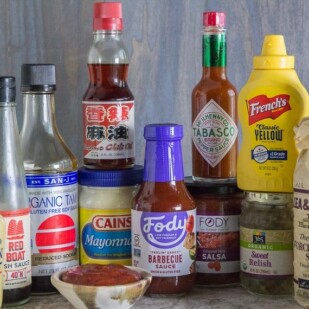All About Low FODMAP Hot Dogs: Buying, Cooking, Enjoying!
Do you like a good “dog”? Hot dogs are a beloved food and there is no reason you have to give them up when following the low FODMAP diet – if you follow our guidelines.
This article is All About Low FODMAP Hot Dogs and will help you enjoy this beloved food, all the while adhering to your diet.
How to Buy Low FODMAP Hot Dogs
Label reading! This is going to be all about label reading – and understanding what it is that you see on the ingredient labels. By their very nature, hot dogs usually have many ingredients and the USDA even allow dairy products, so you have to read carefully.
Pick Your Protein
First you might want to decide whether you want an all-beef, pork, a blend of the two or even chicken or turkey. That way you can limit your label reading to your chosen hot dog category.
As for vegetarian hot dogs, the main ingredients are often isolated soy protein and vital wheat gluten. Isolated soy protein is low FODMAP. Vital wheat gluten, also called simply wheat gluten, is untested and most likely low in FODMAPs. It is made from removing all of the starch (the carbohydrates) from wheat, leaving a protein dense product.
It is, however, high in gluten, FYI. In addition, there are often garlic and onions in vegetarian hot dogs and of course the “natural flavors” that have to be inquired about. Beet powder appears for coloring from time to time.
Cured vs. Uncured
You will notice on labels that the words “cured” or “uncured” appear. These words have their definitions within the culinary world, and then there is the USDA definitions, which are what govern labeling and commercial products.
While home cooks and chefs will use the word “cured” to describe a food that is preserved by brining, smoking, salting or other methods, the USDA defines “cured” as meats that are preserved with synthetic nitrites.
Synthetic nitrites are in foods, such as bacon, that Monash has Certified as low FODMAP. You can read more in our article about Bacon. Synthetic nitrites are simply salt-based preservatives that prevent spoiling and preserve color.
The word “uncured”, which is very common in organic and “all-natural” brands, is in our estimation very misleading. These hot dogs (or bacon, ham, etc.) are cured; they just aren’t cured along the lines of the USDA definition.
These products do not use any nitrites, but they do use ingredients that essentially “cure” the foods. The most common ingredient you will see is celery based, such as celery powder or celery juice.
We have discussed this with Monash researchers and they have not tested any of these types of products cured with celery powder or juice and as such do not recommend them. Also, you might note, that celery is only low FODMAP in small portions .4 ounces/12 g.
That said we have tolerated “uncured” meats with celery content just fine. Talk with your registered dietitian about possibly trying these products. The flavor, by the way, is not different in these “cured” vs. “uncured” products, at least not due to the curing method or inclusion of a celery product.
Skinless or With Skins/Casing
I like a dog with a good “snap”. This happens when a dog has a “skin” or casing. Perhaps you do, too, or maybe you like your hot dogs to have a more consistent texture throughout. The terminology you want to pay attention to is whether the hot dog is skinless, or not.
Casings can be “natural” or they can be manufactured. Natural casings are derived from animal intestines and can also be made from collagen that is derived from the intestines of animals or extracted from other parts of an animal and then processed.
Casings can also be made from cellulose or a synthetic. The synthetic inedible kind are what you find on bologna and are meant to be peeled away and discarded and are not found on hot dogs.
Skinless hot dogs are initially formed with a casing on – that’s how they get their shape – but are sold “skinless”. The one time I like skinless is if I am going to grill or pan-fry as the skins can become tough.
How to Cook a Hot Dog
Hot dogs are pre-cooked so all you have to do is heat them up, either with steam, gently simmered, grilled or pan-fried. If you want to pan-fry, we recommend splitting them, as in the image below.
Hot Dog Ingredients
Any meat or poultry ingredients are low FODMAP so you have to be aware of the other ingredients, so let’s look at what you might find on the labels.
Sweeteners: Most hot dogs have some sort of sweetener. You want to steer clear of high fructose corn syrup (HFCS) but simple corn syrup is fine, as are various sugars, which you can read more about in our Ingredient Article on Sugar.
Avoid Honey and agave, too, although Monash University has just given a Green Light to up to 1 teaspoon of honey per serving and they have even Certified as Low FODMAP a few foods that contain honey, due to the small amounts per serving in the certified product.
Also be wary of fructose and concentrated fruit juices used as sweeteners.
Spices, Seasonings, Flavorings, Garlic & Onion: If you are familiar with the Monash University Low FODMAP Diet Smartphone App you know that many spices and herbs are low FODMAP and the ones you will typically find on hot dog labels, such as paprika, allspice, red or black pepper are low FODMAP.
Garlic is a very common flavoring ingredients found in hot dogs and it is considered a high FODMAP food due to the fructans. There are food products that are Certified as Low FODMAP by Monash University that contain small amounts of garlic, such as Worcestershire sauce – and it all comes down to serving size. Talk to your registered dietitian. Ditto for onion.
The biggest issue is when you see the words “natural flavorings” or “flavorings”. Unfortunately for us FODMAPers, the USDA allows garlic and onion derivatives (juice, powder, etc.) to be hidden within these terms.
In this case if you want to know whether that brand’s “flavorings” are derived from garlic and/or onion, you will have to call the manufacturer. Our experience has been poor, with companies as varied as Unilver to Whole Foods.
It has not been unusual for their corporate and media relations to tell us that the information is ”proprietary” and that since garlic and onion are not one of the 8 top allergens (fish, shellfish, soy, nut, milk, egg, wheat, peanut) that they are not willing to share any further information.
Coloring: If you stand in front of the hot dog case at the supermarket and get through the brightly colored wrappers, you will see the color of the actual dogs and they vary from pale to quite richly colored. Some of this is due to preservatives (curing) and some of this is due to added colorants.
Some typical colorants found on hot dog labels are cherry powder or beet powder. Cherries themselves are high FODMAP and beets are only low FODMAP in small amounts.
Similarly to the celery-based ingredients above, we suggest that you talk to your registered dietitian about the possibility of trying hot dogs that have these ingredients (which are minimal, by the way).
Cherry powder also provides some preservative function, FYI.
Other Common Hot Dog Ingredients & Terms
Here we list alphabetically other typical hot dog ingredients and terms that you will find on labels and simply give you a Low FODMAP, High FODMAP or Untested designation, where applicable.
Antibiotic Free: This means that any meat used is from animals raised without antibiotics. No issue in regards to FODMAPs. This is a personal choice.
Ascorbic Acid/Sodium Ascorbate: Also known as Vitamin C. Low FODMAP
Autolyzed Yeast Extract: Flavor enhancer derived from yeast and used to add a savory, meaty flavor. Untested. Discuss with your registered dietitian to assess sampling but it is likely low FODMAP.
Citric acid: A naturally occurring acid derived from fruits and vegetables commonly used to control the acidity of products. Low FODMAP.
Dextrose: This ingredient functions as a sweetener as well as a flavor and color enhancer/stabilizer. It is typically derived from fruit or starch and is considered Low FODMAP.
Hormone Free: This indicates that any meat used is from an animal raised without added hormones. No issue in regards to FODMAPs. This is a personal choice.
Hydrolyzed Vegetable Protein: This processed ingredient is used as a flavor enhancer and can be derived from cereals or legumes, such as soy, corn, or wheat. It is difficult to make a blanket statement for a few reasons. First of all, there are certain soy proteins, such as soy protein isolate, that are within low FODMAP foods.
Hydrolyzed vegetable protein has not been tested and we simply do not know its FODMAP content, although it is a ”protein”. Our Success Team RD Vanessa Cobarrubia says that if a vegetarian hot dog is mostly made up of this ingredient, that it would be of a greater concern for her. On the other hand, if it is a minor ingredient in a meat-based hot dog, she suggests discussing with your RD to assess testing it yourself.
Lactate/Diacetate: These are sodium or potassium salts that inhibit growth of bacteria. Typically derived from corn via fermentation. Untested. Discuss with your registered dietitian to assess sampling but it is likely low FODMAP.
Lactose and Milk Products: Why anyone would put a dairy product in a hot dog might seem odd, but you will find these listed. Better to steer clear, unless you have passed the lactose Challenge.
Lauric Arginate: This ingredient prevents bacterial growth. It is a derivative of lauric acid, which is commonly found in coconut and palm kernel oils. Untested. Discuss with your registered dietitian to assess sampling but it is likely low FODMAP.
Maltodextrin: A food additive that is used to aid in food preservation and used as a filler for bulk. It can be made from any starch, most often corn or wheat. It is thought to be safe for those following a gluten-free diet, even when derived from wheat as the proteins are removed during processing. That said, it is an ingredient that FODMAPers should keep an eye on as the jury is out as to whether it is low FODMAP or not. Speak with your registered dietitian about trying foods that contain this ingredient. In small amounts, you might be just fine!
Modified Food Starch: This ingredient is found in many prepared products and is used as a thickener. It is most often made from corn, but it can also be made from wheat or potatoes. It is considered Low FODMAP.
Monosodium Glutamate (MSG): Glutamate and MSG provide the savory umami flavor common in aged meats, mushrooms, anchovies and Parmesan cheese, all of which contain naturally occurring MSG. MSG as an additive is untested and might end up being low FODMAP, however, it has been known to cause digestive upset in some people.
Our Success Team RD Vanessa Cobarrubia says that while she does not tell her patients to avoid it, she does suggest noting in a food log whether many MSG rich foods trigger symptoms. Although untested, you might consider trying foods that contain MSG. Untested. Discuss with your registered dietitian to assess sampling but it is likely low FODMAP.
Oleoresin of Paprika: This is the technical name for paprika extract which is a natural food ingredient extracted from red peppers. It is used for both flavor and its natural red coloring and should be fine in small amounts, although untested.
Organic: This designates that the item is produced using ingredients approved as organic by the USDA. No issue in regards to FODMAPs. This is a personal choice.
Phosphates: These are the naturally occurring form of the element phosphorus and are often used in prepared meat and poultry products for maintaining moisture and to retard off flavors from developing. Sodium or potassium phosphates are common in hot dogs. Untested but likely low FODMAP.
Salt: Salt is used for flavor as well as preservation. Low FODMAP.
Smoke Flavoring: This is such a misunderstood ingredient as it “sounds” fake, but it is literally condensed smoke that is made by capturing and subsequently condensing smoke particles from burning wood. Sometimes the wood source is named, such as maple or hickory.
That’s it; nothing else added. Untested by should be low FODMAP.
Sodium Erythorbate: This ingredient is an antioxidant structurally similar to vitamin C and is added to food for its curing and coloring properties. It is often found in prepared foods along with erythorbic acid as food preservatives ever since the FDA banned the use of sulfites. Untested but likely low FODMAP.
Sorbitol: This is a high FODMAP sugar and should be avoided. Sugars ending in -ol, such as mannitol or maltitol should be avoided, too, as they are polyols (FODMAPs).
Soy Protein: Our Success Team RD Vanessa Cobarrubia says that this ingredient listing is too vague. Consider this untested and please discuss with your registered dietitian.
Hot Dog Buns
Most likely you are going to want a hot dog bun, and again, label reading is a must. It is a good idea to start by looking at gluten-free versions, and then keep an eye out for fillers like inulin, the sweeteners that you might want avoid – typically agave and honey.
Or, you could eat your dog wrapped in lettuce, as shown in our image below.
Brands of Hot Dogs & Buns We Recommend
None of these hot dogs have been lab tested for FODMAP content. We are recommending them based on knowledge of their ingredient FODMAP content. In some case you will see a potentially high FODMAP ingredient listed on a label, such as cherry powder, but it is in very small amounts and there has been anecdotal evidence that FODMAPers can tolerate the product.
Your individual experience might vary.
You are in charge of your body and what foods you choose to eat. Apparently some FODMAPers have been in contact with the Ball Park Franks manufacturer and they were told that all of their franks contain garlic (within the “flavorings”) and so we have not included them here.
That said, note that the “flavorings” are under 2%, so you might still want to give that brand a try.
Use your best judgment.
As always, if you have any questions please discuss with your registered dietitian, but here is our caveat: if your IBS symptoms are stable and you have a good understanding of your own digestive process, trying one of these hot dogs (or half a hot dog to start) could be a prudent way to assess your own reactions.
Do this far ahead of the family party! Be smart!
Hot Dog Brands That Might Be Tolerable for FODMAPers
-
- Hoffman German Brand Franks (does contain “flavorings” but it is less than 2%)
- Oscar Meyer Classic Beef Uncured Franks (contain less than 2% cherry powder and “flavorings”)
- Oscar Meyer Premium Beef Franks (less than 2% “flavor”)
- Oscar Meyer Premium Jumbo Beef Franks (less than 2% celery juice, cherry powder and “flavor”)
- Oscar Meyer Jumbo Angus Beef Uncured Franks (less than 2% celery juice, cherry powder and “flavor”)
- Oscar Meyer Turkey Uncured Franks (less than 2% celery juice, cherry powder and “flavor”)
- Wellshire Uncured Cocktail Franks (“Natural flavorings” is last ingredient)
- Zweigle’s Frankfurts Lite (does contain “flavorings” but it is less than 2%)
- Quorn Hot Dogs (the “Mycoprotein” in quorn is low FODMAP and we confirmed with the manufacturer that there are no onion or garlic derivatives; they are vegetarian but not vegan) EDITORS NOTE: As of July 11, 2018 we received another email, unsolicited, from Quorn customer service, which states that their hot dogs DO contain onion and garlic, but that their frankfurters do not. We have contacted them again for clarification. Stay tuned.
Vegan Carrot Hot Dogs! Yes, You Read That Right
Our Success Team RD Rachel Meltzer Warren told us about vegan carrot hot dogs. Yup and you can see them here and here. These recipes are not low FODMAP but you could try creating your own version – if you were so inclined.
Potential Low FODMAP Hot Dog Buns
- Franz Gluten Free Hot Dog Buns
- Canyon Bakehouse Gluten Free Hot Dog Buns
- Udi’s Gluten Free Hot Dog Buns: these contain “sugarcane fiber” but many folks have done well with these.
Get Creative with Hot Dogs – The Low FODMAP Way!
Sure you can steam or grill a hot dog and slap it on a bun, maybe present some low FODMAP condiments, but what about getting more creative?
-
- German Style: Add 1 tablespoon sauerkraut per servings – and some spicy mustard.
- Cheese Dog: A slice of American or cheddar cheese can be melted on top.
- Mexican Style: How about a tablespoon of low FODMAP salsa (like FODY’s) on top instead of ketchup?
- BBQ Dog: Low FODMAP BBQ Sauce makes a great hot dog topper. Again, we love FODY’s version.
- Everything Dog: Be wary of Stacking FODMAPs, but dabbing a bit of mustard and ketchup and relish all together creates tons of flavor and texture.
And if you are a BURGER person, we get it. Check out our most fabulous Low FODMAP Burger Recipe!
We even have a Salmon Burger for you and a Lamb Burger! We don’t want to leave anyone out!
Read our companion article on Low FODMAP Condiments and get to your summer eating!












I like your low fodmap way! Thanks for sharing this info. I actually, have found some instant Low Fodmap recipes Here:
https://casadesante.com/blogs/news
So glad you found this helpful!
Love the warm spinach and strawberry salad , so good thanks for sharing the recipe .
Also very helpful information about the hot dogs.
I might even try a Costco hot dog again but I’ll bring my own Udi’s bun ,
Thank you for letting us know that the hot dog article was helpful. The more we know the more we can help our IBS – and the more we can eat!
Thank you for your excellent article. With the knowledge you shared, I can expand on what my husband will be able to enjoy without the pain.
Thank you! Enjoy.
My understanding of the low FODMAP diet is not to have sauerkraut but yet you advertise for German hot dogs? It’s a bit contradicting if one can eat hot dogs without sauerkraut! 🧐
Hi Heather, actually you CAN have sauerkraut! And ITA, I have to have mustard and sauerkraut with my dogs. Always check your Monash app – EVERYONE following this diet should have this app. We consider it a MUST HAVE. 1 Australian tablespoon or 20 g is low FODMAP.
I just bought the oscar mayer natural selects beef hot dogs after reading your blog and checking ingredients at my local grocery store. After picking them up curbside I discovered that they contain dried garlic and therefore I can’t eat them. This ingredient is not listed anywhere, except on the packaging. I double and triple checked ingredients on the heb website and on oscar mayer’s website, so be careful with oscar mayer!
The garlic in the product is less than 2% which is typically considered tolerable for most people with IBS and therefore a reasonable though FODMAP product. Please review our article about this kind of labeling
Reading all these individual ingredients for a hot dog, well I may be in the store for a half hour for 1 item. A simple list may be easier. This makes this diet extremely frustrating.
Hi Chris, there is a list of recommended hot dogs in the article. The list of ingredients has explanations so that the reader can become an educated consumer. We find that this diet does not lend itself to short-hand. That is when mistakes are made or information is incomplete. It is like when the MD hands you a sheet of paper and it says not to eat bananas and labels them as high FODMAP. Then folks think they cannot eat bananas, which is not even half of the banana story. You might find our Shopping Lists helpful. Might be a more direct way for you to learn about products.
Do you know of any hot dogs that “don’t” contain paprika?
I have never done a search for that.